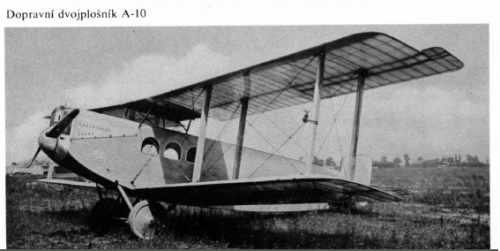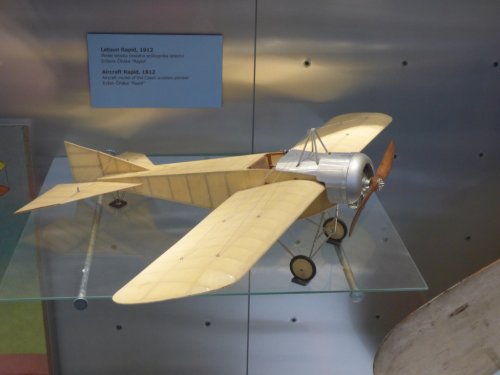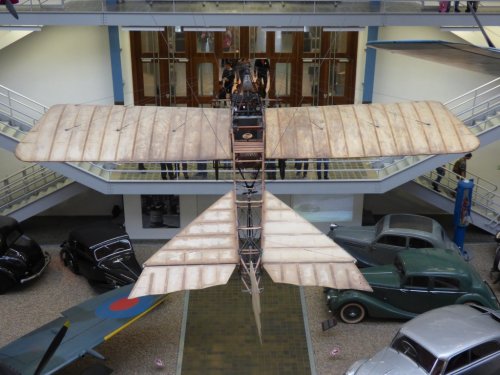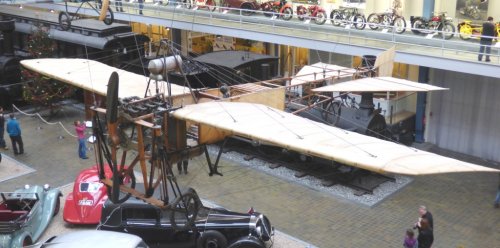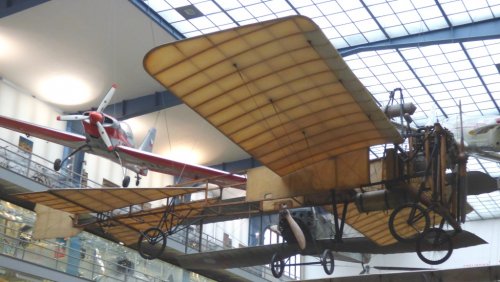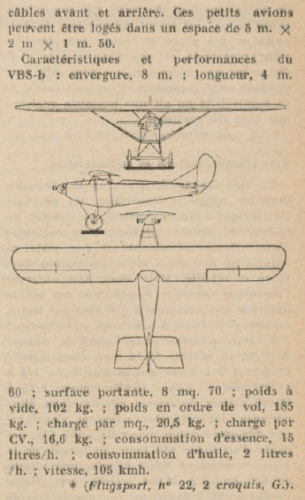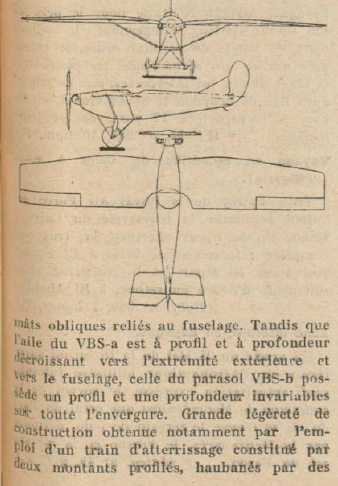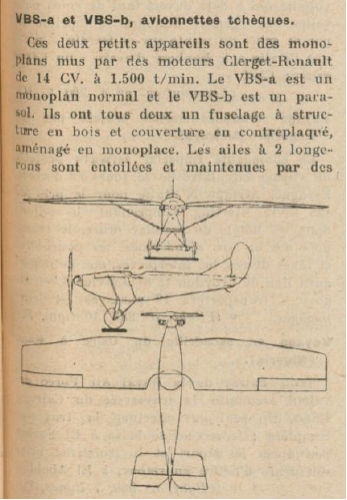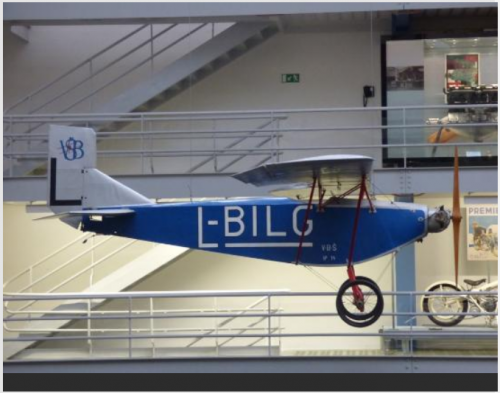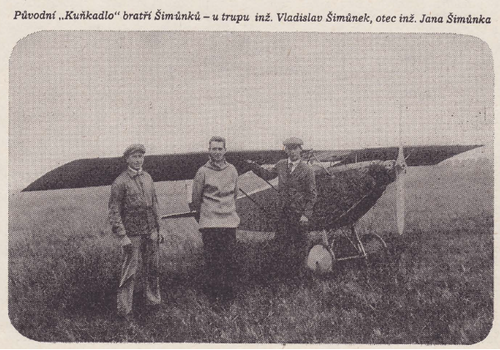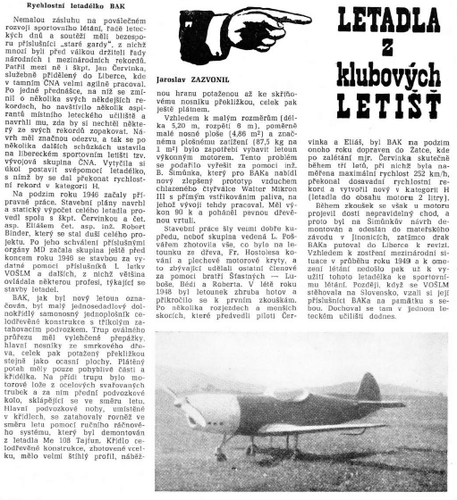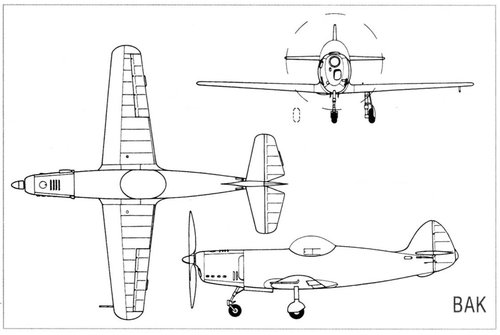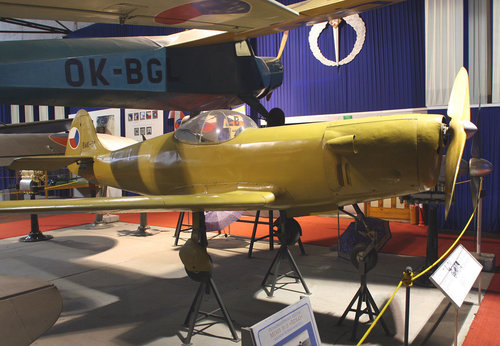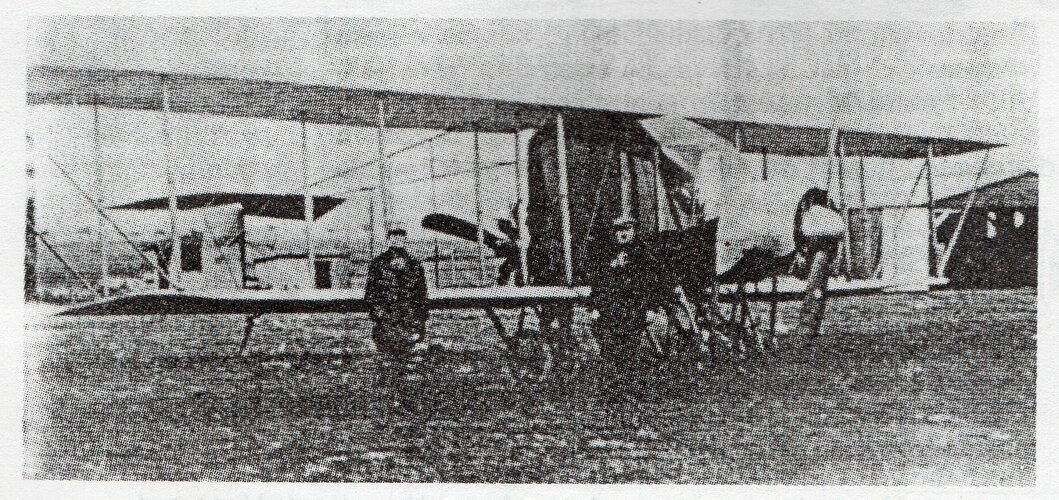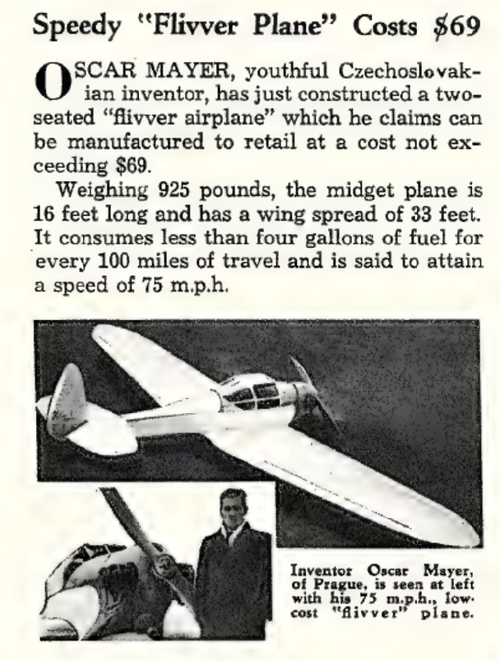You are using an out of date browser. It may not display this or other websites correctly.
You should upgrade or use an alternative browser.
You should upgrade or use an alternative browser.
Various Czechoslovak Little Known Designers & Aircraft
- Joined
- 6 September 2006
- Messages
- 4,838
- Reaction score
- 9,476
Here is some data I got from a website some time ago.
P.14 7.89m span, speed about 630mph, 1x MK108 30mm
P.4 single-seat advanced trainer 7.62m span, 1x Argus As 10c piston driving a tractor propeller, provision for one 7.92mm MG in wing and light bombs. In appearance it loked very much like a mini FW190. I think it flew in 1944 but I'm not entirely sure.
Also some data on the Aero 304/404.
Aero A.304/404 1936 span 19.20m, length 13.20m height 3.40m and wng area 46m2, A.304 2x360hp Walter Pollux IIR piston engines or A.404 430hp Walter Super Castor I-MR, max speed 199mp, range 560 miles. The armament of the A.404 was 2x7.9mm MG in nose and dorsal mounts and bombs. The A.304 carried 2crew + 10 passengers and the A.304 3 crew.
Sorry I have no pictures to add.
P.14 7.89m span, speed about 630mph, 1x MK108 30mm
P.4 single-seat advanced trainer 7.62m span, 1x Argus As 10c piston driving a tractor propeller, provision for one 7.92mm MG in wing and light bombs. In appearance it loked very much like a mini FW190. I think it flew in 1944 but I'm not entirely sure.
Also some data on the Aero 304/404.
Aero A.304/404 1936 span 19.20m, length 13.20m height 3.40m and wng area 46m2, A.304 2x360hp Walter Pollux IIR piston engines or A.404 430hp Walter Super Castor I-MR, max speed 199mp, range 560 miles. The armament of the A.404 was 2x7.9mm MG in nose and dorsal mounts and bombs. The A.304 carried 2crew + 10 passengers and the A.304 3 crew.
Sorry I have no pictures to add.
- Joined
- 28 January 2008
- Messages
- 635
- Reaction score
- 512
Eugen (Eugene) Čihák Rapid (1912)
One of the first pioneer designers of Czech aviation, Eugen (Eugene) Čihák was born on May 31, 1885 in Vinkovič in Croatia in what is now Yugoslavia. His father Ing.František Čihák worked in the service of the Austro-Hungarian Railways. Mother Marie Čiháková born in Kasparov and was the cousin to Ing. Jan Kaspar, the first Czech aviator.
Eugen Čihák and Jan Kašpar built a workshop at the army training field at Pardubice (Czech Kingdom, part of Austria-Hungary) and in 1910 they finished the monoplane powered with a Kašpar-Čihak design of unknown power rating, of their own design. The monoplane made only short hops due to engine of low power so they decided to mount engine Anzani of 25 HP. Jan Kašpar made a ten minutes flight and then he crashed on the first flight and the aircraft wrecked. Kašpar went to France and there bought a new monoplane Blériot, which he later used as a basis for his own design, the Kaspar JK (see next post).
Eugene Čihák designed the pre-war Rapid with his brother Hugo, which outclassed most of the contemporary types. It was a single-seat monoplane and was built along the lines of early Morane monoplanes. Pyramidal tube raised tower in front of the pilot and behind the rotary engine allowed the bracing wires to go down to the wings.
The photo of the Čihák Rapid (1912) is from the early years of flight gallery at Národní Technické Muzeum (NTM) Prague.
One of the first pioneer designers of Czech aviation, Eugen (Eugene) Čihák was born on May 31, 1885 in Vinkovič in Croatia in what is now Yugoslavia. His father Ing.František Čihák worked in the service of the Austro-Hungarian Railways. Mother Marie Čiháková born in Kasparov and was the cousin to Ing. Jan Kaspar, the first Czech aviator.
Eugen Čihák and Jan Kašpar built a workshop at the army training field at Pardubice (Czech Kingdom, part of Austria-Hungary) and in 1910 they finished the monoplane powered with a Kašpar-Čihak design of unknown power rating, of their own design. The monoplane made only short hops due to engine of low power so they decided to mount engine Anzani of 25 HP. Jan Kašpar made a ten minutes flight and then he crashed on the first flight and the aircraft wrecked. Kašpar went to France and there bought a new monoplane Blériot, which he later used as a basis for his own design, the Kaspar JK (see next post).
Eugene Čihák designed the pre-war Rapid with his brother Hugo, which outclassed most of the contemporary types. It was a single-seat monoplane and was built along the lines of early Morane monoplanes. Pyramidal tube raised tower in front of the pilot and behind the rotary engine allowed the bracing wires to go down to the wings.
The photo of the Čihák Rapid (1912) is from the early years of flight gallery at Národní Technické Muzeum (NTM) Prague.
Attachments
- Joined
- 28 January 2008
- Messages
- 635
- Reaction score
- 512
Kaspar JK-Bleriot (1911)
One of the most important figures in early Czech aviation was Ing. Jan Kaspar from Pardubice. Kaspar was one of the early figures to successfully fly a heavier than air machine. As early as April 1910 he made short test flights at Pardubice in an imported Bleriot XI monoplane.
In 1913 he constructed his own all-wooden aeroplane which was derived directly from his original Bleriot. Instead of the original 3-cylinder Anzani engine, Kaspar installed a water-cooled 4-cylinder Daimler (70 hp) motor. This led to a top speed of 90-100 km/h.
In this machine Kaspar made the first real long-distance flight in Czech history on 13th May 1911. It lasted 92 minutes and Kaspar covered 121 km from Pardubice to Prague.
Kašpar later donated the aircraft in which he flew to Prague to the Technical Museum of the Czech Kingdom in 1913. Today, suspended in the transportation hall of the Národní Technické Muzeum, it is one of the most significant exhibits documenting Czech history of aviation. The aircraft was completely restored in 1966.
Jan Kašpar was the cousin of fellow Czech pioneer Eugene Čihák. Kašpar died on 2 March 1927.
Source:
Národní Technické Muzeum
One of the most important figures in early Czech aviation was Ing. Jan Kaspar from Pardubice. Kaspar was one of the early figures to successfully fly a heavier than air machine. As early as April 1910 he made short test flights at Pardubice in an imported Bleriot XI monoplane.
In 1913 he constructed his own all-wooden aeroplane which was derived directly from his original Bleriot. Instead of the original 3-cylinder Anzani engine, Kaspar installed a water-cooled 4-cylinder Daimler (70 hp) motor. This led to a top speed of 90-100 km/h.
In this machine Kaspar made the first real long-distance flight in Czech history on 13th May 1911. It lasted 92 minutes and Kaspar covered 121 km from Pardubice to Prague.
Kašpar later donated the aircraft in which he flew to Prague to the Technical Museum of the Czech Kingdom in 1913. Today, suspended in the transportation hall of the Národní Technické Muzeum, it is one of the most significant exhibits documenting Czech history of aviation. The aircraft was completely restored in 1966.
Jan Kašpar was the cousin of fellow Czech pioneer Eugene Čihák. Kašpar died on 2 March 1927.
Source:
Národní Technické Muzeum
Attachments
- Joined
- 26 May 2006
- Messages
- 34,916
- Reaction score
- 15,790
- Joined
- 26 May 2006
- Messages
- 34,916
- Reaction score
- 15,790
Re: Various Czechoslovak Civil Aircraft
It was called Simunek VBS-1
<a href="https://www.tripadvisor.com/LocationPhotoDirectLink-g274707-d318617-i163588069-National_Technical_Museum-Prague_Bohemia.html#163588069"><img alt="" src="https://media-cdn.tripadvisor.com/media/photo-s/09/c0/27/e5/national-technical-museum.jpg"/></a>
This photo of National Technical Museum is courtesy of TripAdvisor
hesham said:From Le Document Aeronautique 1928,
I can't ID those two airplanes or they were a Projects or not ?.
It was called Simunek VBS-1
<a href="https://www.tripadvisor.com/LocationPhotoDirectLink-g274707-d318617-i163588069-National_Technical_Museum-Prague_Bohemia.html#163588069"><img alt="" src="https://media-cdn.tripadvisor.com/media/photo-s/09/c0/27/e5/national-technical-museum.jpg"/></a>
This photo of National Technical Museum is courtesy of TripAdvisor
Attachments
- Joined
- 25 July 2007
- Messages
- 4,299
- Reaction score
- 4,197
Re: Various Czechoslovak Civil Aircraft
So, the shoulder-winged VBŠ-a project was dropped in favour of the parasol VBŠ-b - built in 1926 as the prototype VBŠ-1. The VBŠ-1 was otherwise known as the VBŠ Kuňkadlo.
The VBŠ-1 was designed by the brothers Vladimír and Bohuslav Šimůnkov. The latter is often listed as an engine designer for Walter (I assume by confusing him with Ing. Bohumil Šimůnek who designed of the HO2 Praga B for ČKD Praga before going on to the Walter Mikron and Minor series).
BTW, does anyone know if the current aircraft designer Ing. Jan Šimůnek is related to Vladimír and Bohuslav?
hesham said:It was called Simunek VBS-1
So, the shoulder-winged VBŠ-a project was dropped in favour of the parasol VBŠ-b - built in 1926 as the prototype VBŠ-1. The VBŠ-1 was otherwise known as the VBŠ Kuňkadlo.
The VBŠ-1 was designed by the brothers Vladimír and Bohuslav Šimůnkov. The latter is often listed as an engine designer for Walter (I assume by confusing him with Ing. Bohumil Šimůnek who designed of the HO2 Praga B for ČKD Praga before going on to the Walter Mikron and Minor series).
BTW, does anyone know if the current aircraft designer Ing. Jan Šimůnek is related to Vladimír and Bohuslav?
archipeppe
ACCESS: Top Secret
- Joined
- 18 October 2007
- Messages
- 2,431
- Reaction score
- 3,152
I can't ID this well,maybe from CNA and called BAK,but I never heard about it before ?.
Odd, never seen such plane before.
Even more odd the tri-cycle landing gear rarely seen in Italian aircraft up to WWII.
Looks more like Czech stuff with an Italian engine...
Aubi
ACCESS: Secret
Amateur sporting aircraft made by the students of Liberec military technical school, led by the seasoned pilot capt. Jan Červinka, 1948-1949. ČNA means Český národní aeroklub, Czech National Aeroclub, and the makers formally belonged under it. VOSM means Vojenská odborná škola leteckých mechaniků, Military Technical School of Aviation Mechanics. Weird little thing.
- Joined
- 26 May 2006
- Messages
- 34,916
- Reaction score
- 15,790
Thank you my dears,
and please Moderator,we can transfer it to this topic;
and please Moderator,we can transfer it to this topic;
swscotland
ACCESS: Restricted
- Joined
- 11 February 2020
- Messages
- 2
- Reaction score
- 3
Amateur sporting aircraft made by the students of Liberec military technical school, led by the seasoned pilot capt. Jan Červinka, 1948-1949. ČNA means Český národní aeroklub, Czech National Aeroclub, and the makers formally belonged under it. VOSM means Vojenská odborná škola leteckých mechaniků, Military Technical School of Aviation Mechanics. Weird little thing.
Does the BAK stand for something?
I tried to read the PDF posted by Hesham - Google translate is great but often produces some ambiguous sentences. The article talks about the BAK (Flown by Jan Červenka) breaking a world record in 1948 in the category "less than 2 litres" - presumably the engine size. Am I reading this correctly?
Aubi
ACCESS: Secret
Sorry, I didn't find anything about the meaning of BAK. Presumably, B stands for Robert Binder, its chief designer.
You're right about the 2 litres thing, it is engine volume.
You're right about the 2 litres thing, it is engine volume.
- Joined
- 26 May 2006
- Messages
- 34,916
- Reaction score
- 15,790
Welcome aboard Swscotland,
but as you said,hard to get the comprehensive meaning from google translate;
Cervinka skutecne during the three years in which it was measured maximum speed 252 km / h
broke the current speed record and created new ones in category H (aircraft capacity up to 2 liters).
but as you said,hard to get the comprehensive meaning from google translate;
Cervinka skutecne during the three years in which it was measured maximum speed 252 km / h
broke the current speed record and created new ones in category H (aircraft capacity up to 2 liters).
Aubi
ACCESS: Secret
That sentence has very complicated structure and poor Google can't understand. From the beginning of the sentence:
"After few strolls and small jumps, which were performed by pilots Červinka and Eliáš, was BAK during autumn transferred to Žatec, where Major Červinka, after flight testing, during three flights which gave max speed readings of 252 km/hr, really broke the world speed record and made new one in the H cathegory (aircraft with 2 litres of engine volume)."
"After few strolls and small jumps, which were performed by pilots Červinka and Eliáš, was BAK during autumn transferred to Žatec, where Major Červinka, after flight testing, during three flights which gave max speed readings of 252 km/hr, really broke the world speed record and made new one in the H cathegory (aircraft with 2 litres of engine volume)."
swscotland
ACCESS: Restricted
- Joined
- 11 February 2020
- Messages
- 2
- Reaction score
- 3
That sentence has very complicated structure and poor Google can't understand. From the beginning of the sentence:
"After few strolls and small jumps, which were performed by pilots Červinka and Eliáš, was BAK during autumn transferred to Žatec, where Major Červinka, after flight testing, during three flights which gave max speed readings of 252 km/hr, really broke the world speed record and made new one in the H cathegory (aircraft with 2 litres of engine volume)."
Thanks. I read this as meaning he had set an "unofficial" record in the category. I looked on FAI's website and though Jan Červenka held several records, there were none after 1938.
- Joined
- 9 October 2009
- Messages
- 21,979
- Reaction score
- 13,640
I looked on FAI's website and though Jan Červenka held several records, there were none after 1938
Doubtless due to Czechoslovakia's dismemberment and ultimate destruction at the hands of the Nazis.
- Joined
- 25 July 2007
- Messages
- 4,299
- Reaction score
- 4,197
Sorry, I didn't find anything about the meaning of BAK. Presumably, B stands for Robert Binder, its chief designer...
If 'B' was for Binder, 'AK' might have been for AeroKlubu as in Českého národního aeroklubu ... since Aeroklubu Liberec ČNA members were attached to VOŠLM.
Aubi
ACCESS: Secret
Czechoslovakia was dismantled by nazis, but it was restored in 1945 and this machine flew in 1948... Anyway, I agree with the idea that the record was unofficial, Žatec is fairly small and I would'nt expect FAI officials wandering there often. Also BAK flew only few times, its engine (Walter Mc aka M-431) was a prototype and soon it started behaving erratingly. It was then was removed and send back to the factory for adjustments and the machine back to Liberec. Soon after, as the article says, "the international political situation changed", i.e. the communist government started tightening the screws, and BAK never flew again. When the VOŠLM moved to Slovakia and BAK with it, where it existed "under development" until 1969, when was BAK transferred to Military History Institute in Prague and subsequently to Kbely.
I saw it several times in the Kbely museum, and never knew what it was. Shame.
AK could definitely mean aeroklubový, i.e. "for aeroclubs", or maybe akrobatický, "aerobatic", or something similar. BAK itself doesn't mean nothing in Czech. maybe there's something about it on the description table in the museum, but i doubt it, and I wouldn't be there again until summer.
I saw it several times in the Kbely museum, and never knew what it was. Shame.
AK could definitely mean aeroklubový, i.e. "for aeroclubs", or maybe akrobatický, "aerobatic", or something similar. BAK itself doesn't mean nothing in Czech. maybe there's something about it on the description table in the museum, but i doubt it, and I wouldn't be there again until summer.
- Joined
- 28 January 2008
- Messages
- 635
- Reaction score
- 512
Štasik Dreadnought No1
In the Journal LHS No 1, there was a photo and brief description of an early Czech twin-engine bomber which bore the description Štasik Dreadnought No1 dating from 1914. It was a large pusher-pull-me biplane which was not very successful.
The aircraft was built in Prague by designer Jan Štasik. Design started in 1913 and the build completed in early summer of 1914. It was possibly the first twin-engine aircraft to be completed in the Austro-Hungarian Empire. The aeroplane carried two crew members who sat in tandem behind the tractor engine. The second engine was at the rear of the fuselage pushing from behind. The bomb load was to be carried in the fuselage behind the crew.
In the autumn of 1914 the completed machine was transported from Prague to Fishamend airfield near Vienna, Austria. It was here that flight trials were to be undertaken. However, the aircraft crashed during the initial take-off attempt when the forward undercarriage collapsed when taxying at high speed. The aircraft was never rebuilt and the aircraft largely forgotten.
Details:
Engines: 2x Gnome Rotary (100 hp)
Wing span: 18.0 m
Empty weight: 750 kg
Normal weight: 1,200 kg
Estimated maximum weight: 2,000 kg
Maximum speed: 150 km/h
Endurance: 6 hours
Crew: Two
Source:
Article entitled “The First Czech Bomber” from Ceskoslovenska Letecka Historicka Spolecnost (LHS) No 1
In the Journal LHS No 1, there was a photo and brief description of an early Czech twin-engine bomber which bore the description Štasik Dreadnought No1 dating from 1914. It was a large pusher-pull-me biplane which was not very successful.
The aircraft was built in Prague by designer Jan Štasik. Design started in 1913 and the build completed in early summer of 1914. It was possibly the first twin-engine aircraft to be completed in the Austro-Hungarian Empire. The aeroplane carried two crew members who sat in tandem behind the tractor engine. The second engine was at the rear of the fuselage pushing from behind. The bomb load was to be carried in the fuselage behind the crew.
In the autumn of 1914 the completed machine was transported from Prague to Fishamend airfield near Vienna, Austria. It was here that flight trials were to be undertaken. However, the aircraft crashed during the initial take-off attempt when the forward undercarriage collapsed when taxying at high speed. The aircraft was never rebuilt and the aircraft largely forgotten.
Details:
Engines: 2x Gnome Rotary (100 hp)
Wing span: 18.0 m
Empty weight: 750 kg
Normal weight: 1,200 kg
Estimated maximum weight: 2,000 kg
Maximum speed: 150 km/h
Endurance: 6 hours
Crew: Two
Source:
Article entitled “The First Czech Bomber” from Ceskoslovenska Letecka Historicka Spolecnost (LHS) No 1
Attachments
- Joined
- 25 July 2007
- Messages
- 4,299
- Reaction score
- 4,197
I never heard before about Oscar Mayer's Flivver monoplane ?
That's because Modern Mechanix has anglicised his name to match that of a better-known German-American wiener maker. A few seconds of online searching reveals that his real name was František Oskar Mayer.
And there is nothing obscure here. František Mayer designed this light aircraft for Baťa (which had taken control of Zlín in November 1934). Baťa hired several aircraft designers during this period.
Jan Kryšpín (1933), František Oskar Mayer (1934), Jaroslav Lonek (1935-1938). However, they left the company prematurely because they encountered problems stemming from Jan A. Baťa's interference...
-- https://web.kurzy.cz/wiki/w/index.php?title=Baťova_letecká_společnost&diff=prev&oldid=21412856
Hi,
the whole career of Oskar Mayer with various Czechoslovak aircraft manufacturers was described by Václav Němeček in the magazine Letectví in 1951. Before 1939 he developed a new method of controlling light aircraft which, according to his calculations, guaranteed not only sufficient stability but also such simplicity of control that flying became easy for any layman.
P.S.: The Aviation 1921-1952 magazine is scanned at this link. https://www.digitalniknihovna.cz/nm/periodical/uuid:2ad79230-5682-416e-9d9f-04854c799894
The 1951 edition is unfortunately only up to issue 9. Fortunately, in the Czech Republic you can sometimes find old issues of this magazine...
Source: Aviation 1951




the whole career of Oskar Mayer with various Czechoslovak aircraft manufacturers was described by Václav Němeček in the magazine Letectví in 1951. Before 1939 he developed a new method of controlling light aircraft which, according to his calculations, guaranteed not only sufficient stability but also such simplicity of control that flying became easy for any layman.
P.S.: The Aviation 1921-1952 magazine is scanned at this link. https://www.digitalniknihovna.cz/nm/periodical/uuid:2ad79230-5682-416e-9d9f-04854c799894
The 1951 edition is unfortunately only up to issue 9. Fortunately, in the Czech Republic you can sometimes find old issues of this magazine...
Source: Aviation 1951
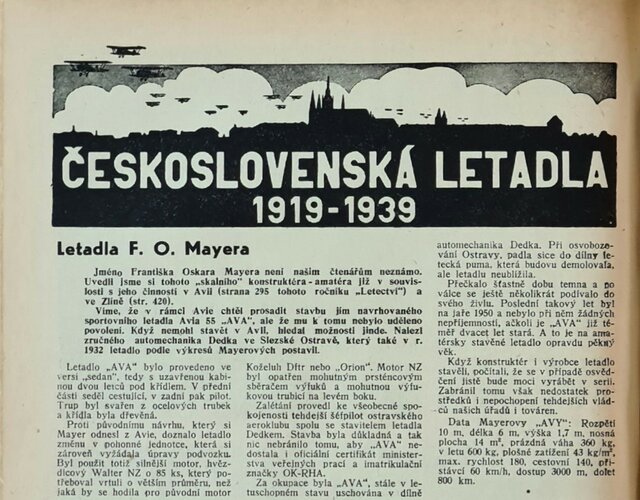
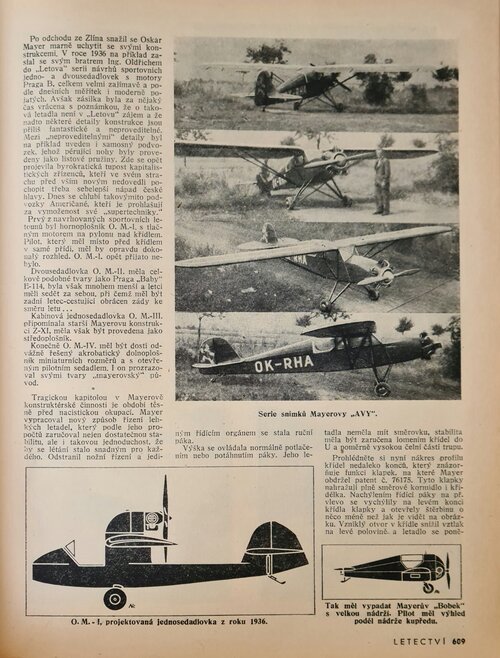
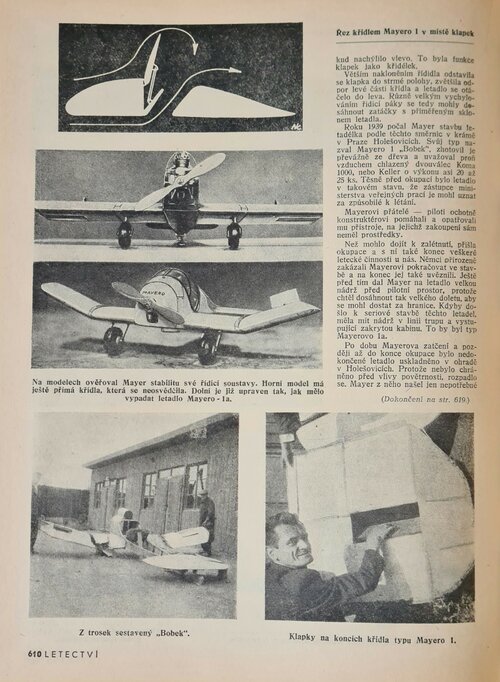
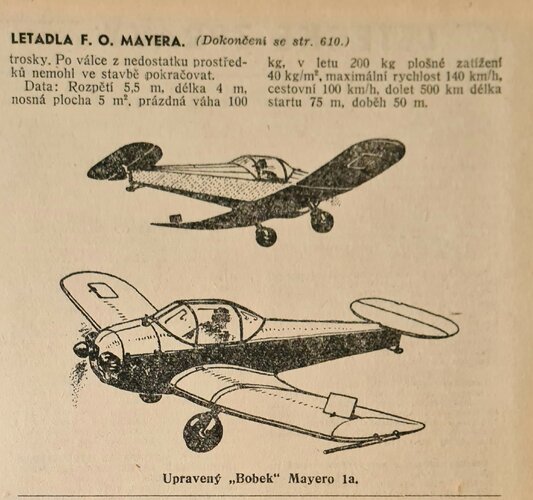
Aubi
ACCESS: Secret
You rang?
The article starts with mentioning previous work of Mayer in the Avia and later in Zlín, with the Avia 55 AVA being developed for Avia but rejected by the company. Mayer then found a skilled car mechanic called Dedek in Moravská Ostrava who in 1932 built the plane from Mayer's drawings.
AVA was finished as a "sedan" i.e. with closed tandem cabin, pilot sat in the back. It differed from the original drawings by having a new engine which caused a redesign of he landing gear. That engine was Walter NZ of 85 metric hp with larger propeller (originally it was to be used to me completely unknown engine Koželuh Dftr or Orion). First flight was satisfactorily performed by the chief pilot of the Ostrava air field together with Dedek. The airplane was deemed to be certifiable by the Ministry of Public Works and received an imatriculation OK-RHA. During the occupation the machina was kept hidden in Dedek's workshop and survived even a random hit by a bom during the liberation of Ostrava, unlike most of the workshop.
It was then flown several times again, for the last time in the Spring of 1950. Despite its proven characteristics it was never built in series due to financial shortage on the side of Mayer and reluctance of established companies.
Data:
Wingspan 10 m / 32 ft 9 ¾ in
Length 6 m / 19 ft 8 ¼ in
Height 1,7 m / 5 ft 6 ⅞ in
Wing area 14 sq.m / 150.69 sq.ft
Empty weight 360 kg / 794 lb
Take-off weight 700 kg / 1543 lb
Wing loading 43 kg/sq.m / 8.81 lb/sq.ft
Top speed 180 kph / 112 mph
Cruise speed 140 kph / 87 mph
Landing speed 60 kph / 37 mph
Ceiling 3000 m / 9843 ft
Range 800 km / 497 mi
The article starts with mentioning previous work of Mayer in the Avia and later in Zlín, with the Avia 55 AVA being developed for Avia but rejected by the company. Mayer then found a skilled car mechanic called Dedek in Moravská Ostrava who in 1932 built the plane from Mayer's drawings.
AVA was finished as a "sedan" i.e. with closed tandem cabin, pilot sat in the back. It differed from the original drawings by having a new engine which caused a redesign of he landing gear. That engine was Walter NZ of 85 metric hp with larger propeller (originally it was to be used to me completely unknown engine Koželuh Dftr or Orion). First flight was satisfactorily performed by the chief pilot of the Ostrava air field together with Dedek. The airplane was deemed to be certifiable by the Ministry of Public Works and received an imatriculation OK-RHA. During the occupation the machina was kept hidden in Dedek's workshop and survived even a random hit by a bom during the liberation of Ostrava, unlike most of the workshop.
It was then flown several times again, for the last time in the Spring of 1950. Despite its proven characteristics it was never built in series due to financial shortage on the side of Mayer and reluctance of established companies.
Data:
Wingspan 10 m / 32 ft 9 ¾ in
Length 6 m / 19 ft 8 ¼ in
Height 1,7 m / 5 ft 6 ⅞ in
Wing area 14 sq.m / 150.69 sq.ft
Empty weight 360 kg / 794 lb
Take-off weight 700 kg / 1543 lb
Wing loading 43 kg/sq.m / 8.81 lb/sq.ft
Top speed 180 kph / 112 mph
Cruise speed 140 kph / 87 mph
Landing speed 60 kph / 37 mph
Ceiling 3000 m / 9843 ft
Range 800 km / 497 mi
Aubi
ACCESS: Secret
After leaving Zlínská letecká, a.s. Oskar Mayer tried several times to find success with his construcitons. In 1936 for example he sent with his brother ing. Oldřich Mayer to the Letov state factory several designs of light one and two-seat sporting palnes with the Praga B engines, the package was delivered back after some time with the note that Letov is not interrested in this class of machines and several of the details are too fantastic for real construction. (Article cites as such detail the cantilever landing gear with leaf spring suspension and blames for that backward thinking the "Capitalist" bureaucrats and someting something evil America)
First there was the O.M.-I high-wing monoplane with pusher engine set above the wing on a pylon. Pilot sat in the nose before the wing.
O.M.-II was a two-seater similar to the Praga E-114 Air Baby but much smaller and with a tandem seating, passenger facing to the rear...
O.M.-III was a cabin one-seater similar to previous Mayer's design, Zlín Z-IX but this time it was a mid-wing design.
O.M.-IV was to be a tiny low-wing aerobatic airplane with open cockpit and typically Mayeresque shape.
Tragic chapter in Mayer's life is the period right before the Nazi occupation. Mayer developd a new method of steering of light airplanes that allegedly promised an increased stability while being very simple and thus clearing a path to flying for everybody. He abandoned all foot control, all was steered with the stick. Height was controlled with pushing/pulling the stick. The plane was to be ruderless, longitudinal stability was to be guaranteed by the U-bend of the wing and a tall profile of the nose.
Near the wing tips there was to be a wing flap that was used both instead of a rudder and th wing ailerons. Moving the stick to the left moved the flap in the left wing, opening a slot that reduced the lift in the wing, which moved the plane to the left. Even larger move of the stick to the left meant that the flap became vertical and the turn tho the left became steeper.
In 1939 Mayer started to building the machine, in a shop in Prague-Holešovice. He called it Mayero 1 Bobek (a tot, or mite, or even coloquially a "little shit"). It was built msotly from wood and it was meant to use either the air-cooled twin-cylinder engine Koma-1000 or Keller with power between 20 and 25 metric hp. Right before the occupation the machina was mostly finished and proclaimed by the Ministry of Public Works as air worthy. Mayer's pilot friends donated to him several instruments needed for completion for which Mayer lacked funds.
Before the machine could be flown the occupaiton came and Mayer was not only prohibited from continuing in his work but later also arrested. Before that, Mayer allegedly put in front of the cockpit a large tank that should grant him a range enough to reach the borders. Proposed Mayero 1a had a tank inside the hull behind the raised covered cockpit.
During the occupation the little shit was kept in an enclosure in Holešovice. Due to the weather it fell apart and after the war Mayer found there a little of anything worthy. Due to the lack of money he couldn't continue with development.
Data:
Wingspan 5,5 m / 18 ft ½ in
Length 4 m / 13 ft 1 ½ in
Wing area 5 sq.m / 53.82 sq.ft
Empty weight 100 kg / 220 lb
Take-off weight 200 kg / 441lb
Wing loading 40 kg/sq.m / 8.19 lb/sq.ft
Top speed 140 kph / 87 mph
Cruise speed 100 kph / 62 mph
Range 500 km / 311mi
Take-off length 75 m / 246 ft
Run-out 50 m / 164 ft
First there was the O.M.-I high-wing monoplane with pusher engine set above the wing on a pylon. Pilot sat in the nose before the wing.
O.M.-II was a two-seater similar to the Praga E-114 Air Baby but much smaller and with a tandem seating, passenger facing to the rear...
O.M.-III was a cabin one-seater similar to previous Mayer's design, Zlín Z-IX but this time it was a mid-wing design.
O.M.-IV was to be a tiny low-wing aerobatic airplane with open cockpit and typically Mayeresque shape.
Tragic chapter in Mayer's life is the period right before the Nazi occupation. Mayer developd a new method of steering of light airplanes that allegedly promised an increased stability while being very simple and thus clearing a path to flying for everybody. He abandoned all foot control, all was steered with the stick. Height was controlled with pushing/pulling the stick. The plane was to be ruderless, longitudinal stability was to be guaranteed by the U-bend of the wing and a tall profile of the nose.
Near the wing tips there was to be a wing flap that was used both instead of a rudder and th wing ailerons. Moving the stick to the left moved the flap in the left wing, opening a slot that reduced the lift in the wing, which moved the plane to the left. Even larger move of the stick to the left meant that the flap became vertical and the turn tho the left became steeper.
In 1939 Mayer started to building the machine, in a shop in Prague-Holešovice. He called it Mayero 1 Bobek (a tot, or mite, or even coloquially a "little shit"). It was built msotly from wood and it was meant to use either the air-cooled twin-cylinder engine Koma-1000 or Keller with power between 20 and 25 metric hp. Right before the occupation the machina was mostly finished and proclaimed by the Ministry of Public Works as air worthy. Mayer's pilot friends donated to him several instruments needed for completion for which Mayer lacked funds.
Before the machine could be flown the occupaiton came and Mayer was not only prohibited from continuing in his work but later also arrested. Before that, Mayer allegedly put in front of the cockpit a large tank that should grant him a range enough to reach the borders. Proposed Mayero 1a had a tank inside the hull behind the raised covered cockpit.
During the occupation the little shit was kept in an enclosure in Holešovice. Due to the weather it fell apart and after the war Mayer found there a little of anything worthy. Due to the lack of money he couldn't continue with development.
Data:
Wingspan 5,5 m / 18 ft ½ in
Length 4 m / 13 ft 1 ½ in
Wing area 5 sq.m / 53.82 sq.ft
Empty weight 100 kg / 220 lb
Take-off weight 200 kg / 441lb
Wing loading 40 kg/sq.m / 8.19 lb/sq.ft
Top speed 140 kph / 87 mph
Cruise speed 100 kph / 62 mph
Range 500 km / 311mi
Take-off length 75 m / 246 ft
Run-out 50 m / 164 ft
Last edited:
Aubi
ACCESS: Secret
Pictures:
OM-I:

Wing cross-section wit the flap, and a picture of the Bobek's wing.


Side-view of how Bobek was to appear after it was fitted with the gasoline tank in the nose. Pilot could see along the tank.

Remnants of Bobek in 1945, put together:

Models used for development of the wing flaps. Lower picture shows the configuration as proposed for the Mayero 1A:

And a drawing of Mayero 1a.
OM-I:
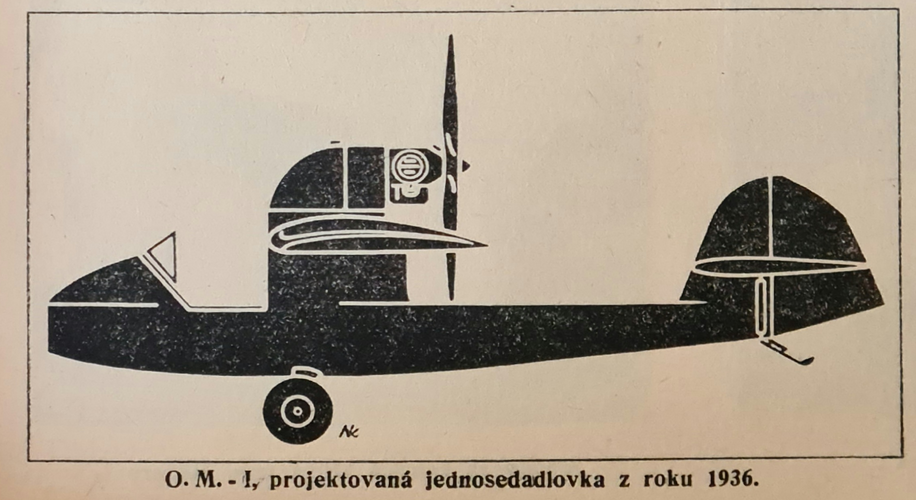
Wing cross-section wit the flap, and a picture of the Bobek's wing.
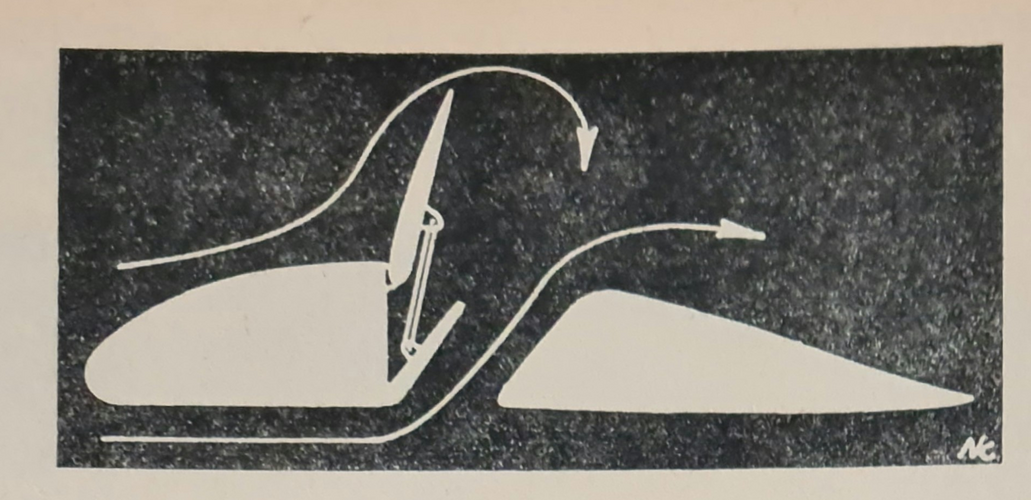
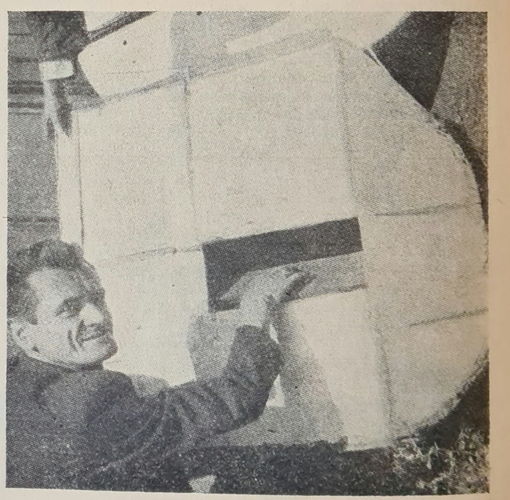
Side-view of how Bobek was to appear after it was fitted with the gasoline tank in the nose. Pilot could see along the tank.
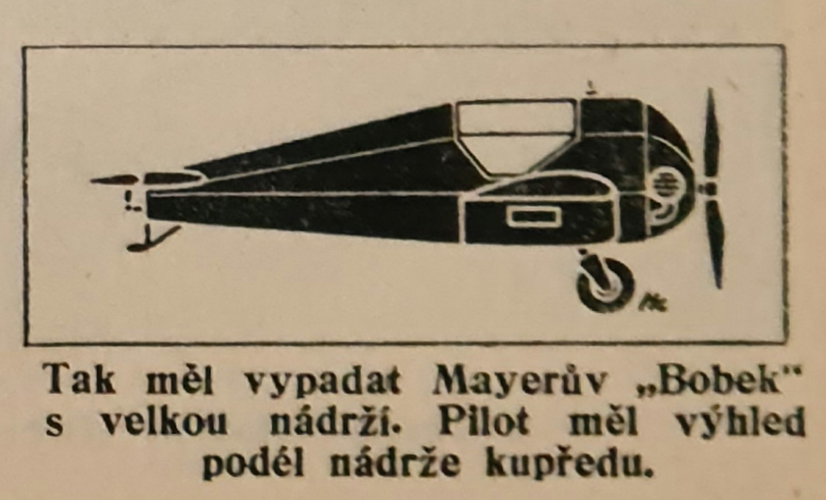
Remnants of Bobek in 1945, put together:
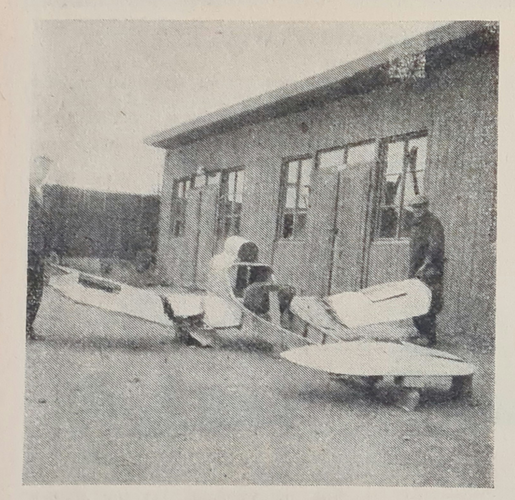
Models used for development of the wing flaps. Lower picture shows the configuration as proposed for the Mayero 1A:
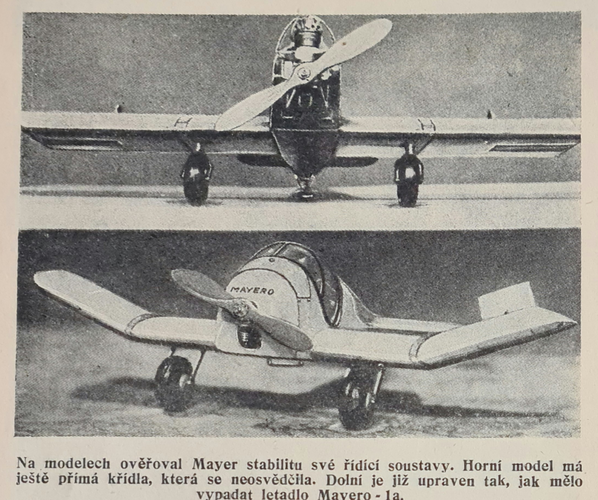
And a drawing of Mayero 1a.

Hi,Pictures:
OM-I:
View attachment 762137
Wing cross-section wit the flap, and a picture of the Bobek's wing.
View attachment 762138
View attachment 762139
Side-view of how Bobek was to appear after it was fitted with the gasoline tank in the nose. Pilot could see along the tank.
View attachment 762140
Remnants of Bobek in 1945, put together:
View attachment 762142
Models used for development of the wing flaps. Lower picture shows the configuration as proposed for the Mayero 1A:
View attachment 762141
And a drawing of Mayero 1a.View attachment 762143
i wanted to translate my post using a translator, but Aubi did it for me and much, much better. Thank you.
PS. Děkuji Vám za úžasný překlad, před Vaší angličtinou hluboce smekám...
Aubi
ACCESS: Secret
Není zač. Pětadvacet let vymetání internetových koutů a nutnost číst odbornou literaturu v originále naučily Dalibora housti.
Similar threads
-
-
-
-
-
Little-Known French Projects and Prototypes
- Started by hesham
- Replies: 746

